Sports
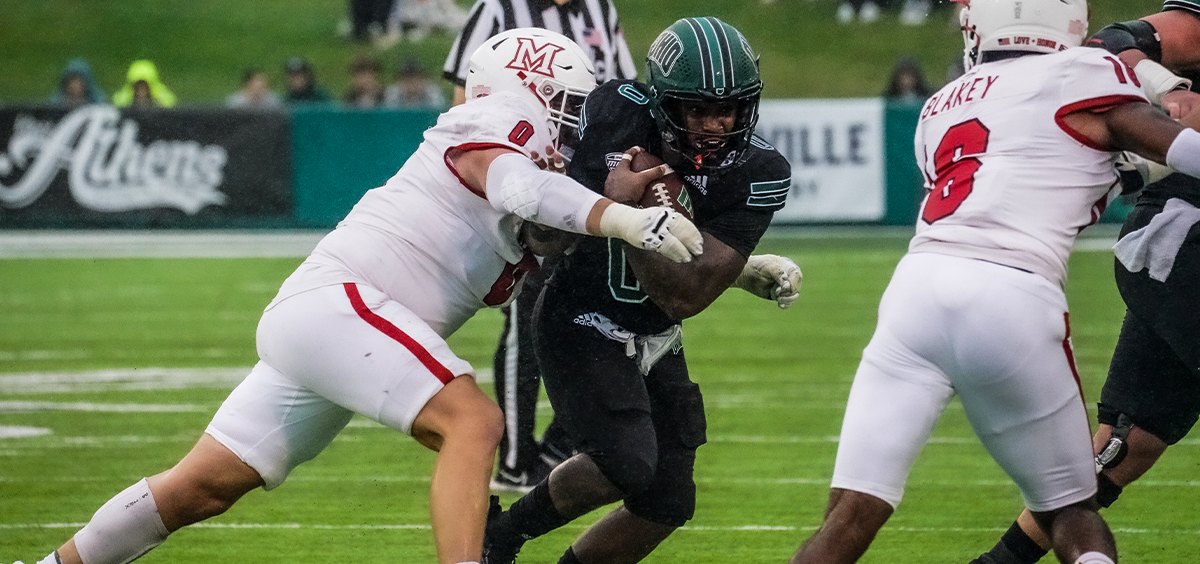
Ohio and Miami set for 100th edition of iconic rivalry
By: Andrew Bowlby
Posted on:
Memorable matchups, legendary faces and a bitter hatred are mere fragments of what makes the Battle of the Bricks rivalry so special.
Few head-to-head matchups reach a level that leads to being played as frequently or as fiercely as Ohio vs. Miami.
The two have played 99 times entering the 2024 matchup, with the inaugural battle coming 116 years ago.
Early Years (1908-1915)
Arthur McFarland and Amos Foster, both in their final year as head coach at their respective schools, led Ohio and Miami respectively into a new era. Miami began the century-long series with a 5-0 win in Athens. The win was part of Miami’s 7-0 campaign, the best at the time since the program began play in 1888.
According to the Miami Recensio 1909, the only points scored in the game were from a touchdown by B.C. Morris.
“Our opponents [Ohio] were determined to win, were rather indifferent as to their methods of doing so, and knew how to play a hard game of old style foot ball,” the Recensio said.
Miami took each of the next three meetings in 1909, 1912 and 1913.
Ohio had to wait until 1914 for its first win against Miami. Through the first two weeks of the 1914 season, Miami was 2-0 and had not conceded a point. On a day with plenty of rain that left a muddy field, Ohio scored a touchdown in the first quarter which proved to be the only points in a 6-0 win.
Miami won the 1915 bout 13-7, the final game between the two schools for the next 13 years.
Miami Leads All-Time Series: 5-1
The Don Peden Era (1928-1942)
The winningest coach in Ohio Football history is still Don Peden. Even though nearly 100 years have passed since his hiring prior to the 1924 season. His first chance to coach against Miami came in 1928, ending the decade plus absence of the rivalry.
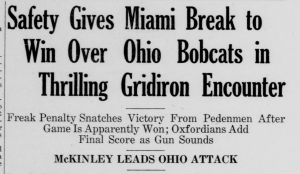
Although Miami got the better of Peden and the Bobcats in the 1928 meeting, that did not stop him for long.
Ohio marched through the next three years beating Miami in all three, giving up just six points along the way. This marked the first time the Bobcats won consecutive games over Miami.
From 1932 to 1936 the two took turns shutting out the other. Ohio won a pair of games by a combined score of 26-0 (1933, 1935), Miami took three games by a total of 26-0 (1932, 1934, 1936).
In the 1937 season, Ohio began a run that is still tied for a school record for consecutive wins over Miami. During the six-game win streak, the Bobcats outscored their opponent 151-32.
Peden’s winning against Miami concluded after the 39-13 victory in 1942. Ohio football took a two-year hiatus during World War II, however, Miami did continue play through the 1943 and 1944 seasons. The two resumed action in 1945, the start of Miami’s best stretch.
Ohio Leads All-Time Series: 12-9
Miami’s 15-game unbeaten run (1945-1959)
Rivalries are expected to be competitive. Going in each year both teams should feel they have a chance to beat the other. And while the Battle of the Bricks was a back-and-forth rivalry through its first 21 meetings, the next 15 were not.
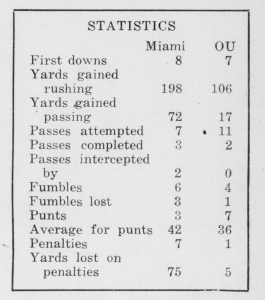
The dawn of this segment was in 1945. Miami’s homecoming, the first one after WWII, drew a crowd over 9,000 to see the rivals meet after a two-season break. Miami converted eight first downs to Ohio’s seven, but still defeated the Bobcats 34-0.
In 1946, Miami once again defeated Ohio, this time just 23-14. During the three-year window of 1947-1949 Ohio was held scoreless. The ‘Cats went nearly 1,500 days between scoring points against Miami.
Ohio finally ended its losing streak in 1953 by putting together a 7-7 tie, the first of two in the all-time series. The draw only offset another lengthy one-sided Miami win streak.
The Red and White took every matchup from 1954 through 1959, totally 14 wins in 15 meetings since 1945.
Bill Hess coached 20 Battle of the Bricks games for the Bobcats (the most all-time on either side). Hess was dejected after watching Ohio lose for the 14th time in 15 years.
“We were defeated by a fine ball club, they made a minimum number of mistakes and capitalized on every opportunity that came their way,” the second-year coach said after losing to Miami.
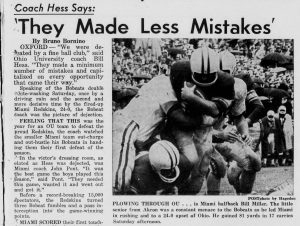
Miami Leads All-Time Series: 23-12-1
30 years of trading wins (1960-1989)
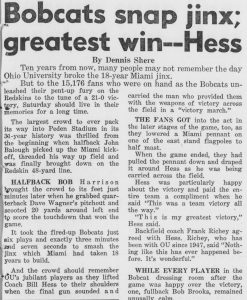
It was clear that Ohio was tired of losing to Miami when the 1960s arrived. For the Green and White, going winless for 18 years was unacceptable. Hess emphasized ahead of the 1960 collision that Ohio was “as ready as we’ll ever be.”
A record crowd of 15,167 people saw Ohio snap an 18-year ‘jinx’ against its arch-rival defeating Miami 21-0. Hess proclaimed it was his “greatest victory” as a football coach.
Beating Miami was part of Ohio’s remarkable 1960 campaign where it was crowned the National Small College Champion.
The early 1960s were good to the Bobcats as they went on to win the next four battles with Miami. Aside from the 61’ game, the next three were one score games, just the second time that had happened.
Miami turned the series back around with a dominant showing in the 1965 game handing Ohio its worst conference loss in over a decade. Followed by two more wins Miami answered the Bobcats’ five-game winning streak with one of their own.
Ohio won the 1968 game on route to an undefeated regular season and a MAC title. The final game of the 60s went to Miami, and the Bobcats finished the decade winning six of 10.
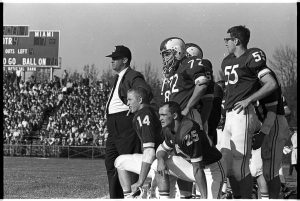
The opening act to the 1970s was one of Ohio’s great wins. Facing a Miami defense that ranked first in the nation, the Bobcats pulled a stunning upset 23-22.
A Steve Skiver 61-yard touchdown pass to Bobby Allen in the third quarter gave Ohio the needed separation to down Miami.
Winning in 1970 was preceded another trilling win in 1971, but in entirely different fashion. The win was arguably sweeter with Miami entering possessing a perfect 4-0 and holding the nation’s best defense once again.
Dave Green knocked through a 41-yard field goal in the third quarter. The only score in a Bobcats upset in Oxford.
Having been upset twice in a row; Miami turned the tide over the next four years rolling through the mid 70s sinking the Bobcats by an average of 16 points per victory.
When the 1970s were all set and done, Miami claimed the decade winning six of 10.
The 1980s were a mere copy of the previous decades. Miami recorded five wins and Ohio racked in four during the first nine games in the 80s. The Bobcats had a chance to get an even split with a win in Oxford, however, could not prevail.
A game that featured seven turnovers, 13 penalties and 800 yards of offense ended in a 22-22 tie, bringing the 1980s section to a close with Miami holding a 5-4-1 record.
Miami Leads All-Time Series: 37-27-2
Randy Walker leads Miami to 90s dominance (1990-1999)
Prior to the 1990 season Miami hired Randy Walker. The same season began a one-sided stretch. The Bobcats had their homecoming spoiled by Miami’s 40-18 triumph.
Miami kept up momentum taking two more over Ohio 34-0 and 23-21 in 1991 and 1992 respectively. The beginning of the 90s was difficult for not only against Miami, but also in general for the Bobcats. Entering Battle of the Bricks week in 1993, Ohio had won just five games since the decade began.
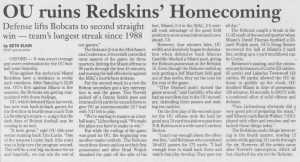
That didn’t stop the Bobcats from going on the road and overcoming Miami on its homecoming. The 22-20 triumph broke up what was nearly a decade sweep for the RedHawks.
After the defeat, Miami answered quickly by putting together a five-game winning streak. The RedHawks averaged 33 points per game during the run. Walker left Miami after 1998 finishing with eight wins over Ohio in nine attempts, the best winning percentage in Miami program history.
Miami Leads All-Time Series: 45-29-2
RedHawks control early 20th century (2000-2005)
Miami’s opening win in 2000 was a miraculous fourth quarter comeback. Trailing 24-13 entering the final quarter, the RedHawks rattled off 14 unanswered points, including an 87-yard game-winning drive.
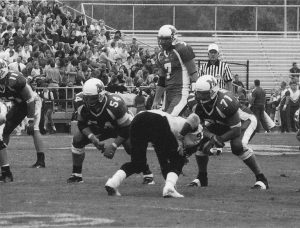
A year later – Miami’s all-time great Ben Roethlisberger, as a redshirt freshman, tossed a then school record five touchdowns, including two in the fourth to take down the Bobcats.
Roethlisberger threw two touchdowns in 2002 and four in 2003 finishing his career with the RedHawks with a perfect 3-0 record against Ohio. Miami put up 49 points in 2003, the highest total by either team head-to-head.
The 2003 season is arguably Miami’s greatest season all-time. The RedHawks were amid a nine-game winning streak when playing Ohio in 03’. That team won out taking the MAC title game against Bowling Green, the GMAC Bowl over Louisville and finishing No. 10 in the AP Poll.
Miami earned its 50th win over Ohio in 2004 when they took the 81st Battle of the Bricks 40-20. One year later – Frank Solich began his tenure with Ohio, and although he lost in his first opportunity against RedHawks that would soon change.
Miami Leads All-Time Series: 51-29-2
Frank Solich Era (2006-2019)
Solich got his first win over the RedHawks in 2006. Coming in the season finale, Ohio made history recording seven MAC wins for the first time in program history. Propelled by Kalvin McRae recording his seventh-consecutive 100-yard rushing game totaling 180 against the RedHawks.
McRae duplicated his performance the next year in his senior season totally 112 rushing yards in Ohio’s second-straight win over Miami. The Bobcats marched through the next four games as well, matching their longest win streak in the rivalry at six straight.

Miami finally put an end to the losing streak with a stunning upset of Ohio in 2012. The Bobcats fell short 23-20 despite out-gaining the RedHawks offense by 40 yards.
Ohio went on another long wing streak in the late portion of Solich’s tenure with the Bobcats. Winning all five matchups from 2013 to 2017. Including the final win over the RedHawks for Solich in 2017 that proved to be one of Nathan Rourke’s best game with the Bobcats.
Finishing with six touchdowns, three passing and three rushing, he propelled Ohio to a commanding 45-28 win under the lights at Peden Stadium.
While Miami would take the final two games against Solich, the legendary coach finished his time with a 11-4 record in the Battle of the Bricks.
Miami Leads All-Time Series: 54-40-2
Recent Years (2020-Present)
The COVID pandemic forced the rivalry to take a game off for the first time in 75 years but resumed in 2021.
A win over the RedHawks in 2021 was a bright spot in a year where Ohio didn’t have many. It was also Tim Albin’s first win as head coach of the Bobcats. Once again, under the lights at Peden Stadium, Nathan Rourke’s brother Kurtis Rourke showed out delivering a win in his first start against the RedHawks.

In Oxford one year later, Kurtis Rourke and Brett Gabbert dueled with three passing touchdowns each. It was the Bobcats claiming yet another victory with a steady performance throughout.
Miami’s win last year was one of grit and brilliant defense. Holding an explosive Ohio offense to just 16 points. Rashad Amos rushed for 166 yards and scored once, silencing an Ohio home crowd with high expectations. The RedHawks went on to claim a MAC Championship.
Miami Leads All-Time Series: 55-42-2
Rivalries, not dissimilar to the Battle of the Bricks are what make sports. A college athletics world that is seeing rapid realignment and change has seen historic rivalries lost.
The Battle of the Bricks has survived the testament of time and remains the most anticipated game of each season, and will stay that way for the foreseeable future.


![OU sophomore wide reciever Robbie Walker (#18) catches a pass from Derrius Vick during the homecoming game against rival Miami University on Saturday, Oct. 10,2015 at Peden Stadium in Athens, Ohio. The Bobcats defeated the Red Hawks 34-3. [WOUB Public Media]](https://woub.org/wp-content/uploads/2015/10/20151010_OUFootballvsMiami_Raucheisen_004-1024x682.jpg)
![Quarterback Kurtis Rourke (7) throws a pass to Miles Cross (19) in Ohio's game against Miami. [Conor Mallonn | WOUB]](https://woub.org/wp-content/uploads/2023/10/DSC04048-Large-1024x683.jpeg)
![Miami wide receiver Kevin Davis (8) takes a bow after scoring a touchdown in Ohio's game against Miami.[Conor Mallonn | WOUB]](https://woub.org/wp-content/uploads/2023/10/DSC04410-Large-e1698543417314-1024x559.jpeg)
![Referee stands on the line of scrimmage in Ohio's 1990 Homecoming game vs Miami. [Alden Library Archives]](https://woub.org/wp-content/uploads/2024/10/1990-1024x695.jpg)
![Miles Cross catches a pass while being covered by Miami defensive back John Saunders Jr [Alex Eicher | WOUB]](https://woub.org/wp-content/uploads/2022/12/MIAMI-PIC-4-1024x683.jpg)
![Nathan Rourke (12) runs past a Miami defender for a touchdown during the Bobcats' 24-21 loss to Miami on November 6, 2019. [Ben Weilgopolski | WOUB]](https://woub.org/wp-content/uploads/2019/11/DSC_0094-2-1024x683.jpg)